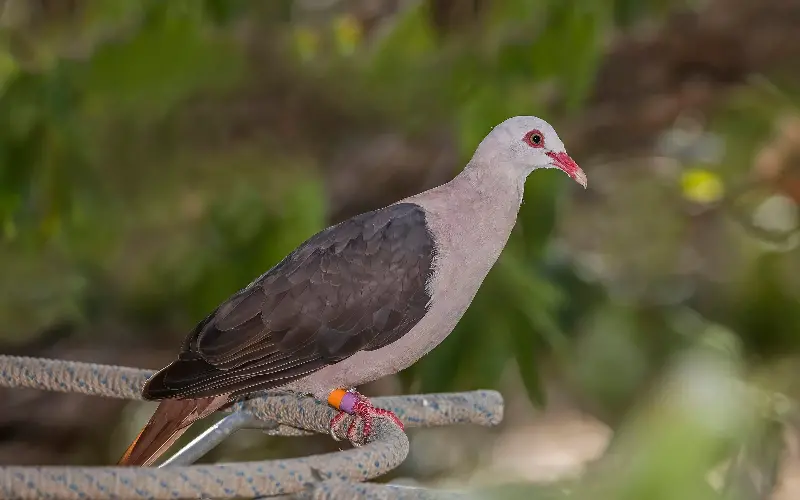
Endangered species could be saved from extinction after scientists were given the green light to create gene-edited animals using DNA from museum specimens.
Conservationists have voted to create the first policy for synthetic biology in what has been described as a milestone for science.
It paves the way for critically endangered species such as the pink pigeon and black-footed ferret to be brought back from the brink.
Synthetic biology methods, such as gene editing and other laboratory techniques, will be used in addition to existing approaches to conservation, and approval of any genetic methods will be given on a case-by-case basis.
Scientists have been divided for eight years on whether gene editing should be allowed as a conservation tool.
The technology which allows the integration of DNA from one animal into another already exists, but ethical issues have long surrounded its potential use in wild animals.
Some scientists want to use Crispr, the Nobel prize-winning “genetic scissors”, to insert helpful genes from long-dead animals into the DNA of endangered species to widen the gene pool.
This would assist their survival, as limited genetic variation makes a species more prone to disease and less able to evolve and adapt to climate change, shrinking habitat or other pressures.
Permission has been granted to seek approval to begin the process. The first step involves scouring museum samples to find desirable genes which have disappeared in living animals.
Scientists want to identify which genes from dead animals would be useful to living animals and then insert them into an embryo of an endangered animal, taking out the inferior versions inherited from its parents and replacing them with the older, healthier alternatives which have disappeared from the gene pool.
This animal would be born into a breeding programme and then bred normally, and its offspring would be released into the wild to spread the genes further afield. This two-generation approach would make the gene flow easy to follow, and allow for close study for any negative side effects or unsuspected traits.
A breeding programme with these genetically modified animals would then create further progeny which have much improved genetic diversity for future generations.
“So basically you reintroduce their offspring,” Prof Cock van Oosterhout, professor of evolutionary genetics at the University of East Anglia, told The Telegraph.
“So you don’t even release the individuals that you actually have been tinkering with. You use their offspring, which are basically a cross between a wild individual and that individual that you have genetically engineered.”
Long-term safety
This would fix the issue of inbreeding and a DNA bottleneck that happens when a species is in severe decline and becomes isolated.
But critics warned that not enough is known about the long-term safety of such a programme of GM conservation. Others said it was the only way to save the most severely threatened species from a best-case future of inbreeding and poor health, and a worst-case scenario of inevitable extinction.
For years the field has been split, with one side pushing for a regulatory process to be accepted for case-by-case approval of GM methods, while the other side wanted an immediate moratorium.
Crunch talks held at the IUCN Congress in Abu Dhabi last weekend brought together both sides and a vote went in favour of the advocates, bringing genetically modified conservation one step closer to reality.
Prof van Oosterhout thinks it will be decades before gene-edited animals are a part of conservation projects.
“The accepted motion at IUCN Congress has made the policy a little bit less black and white,” he told The Telegraph.
“It’s also not a green card or an acceptance that synthetic biology now is always accepted. It’s actually more under particular conditions and all these other caveats that they have included in there.
He added: “The Victorians, and even before them, collected so many specimens in museums and they are wonderful resources for DNA.
“If we can use that DNA from populations before they reach a genetic bottleneck, then we can reintroduce genetic variation that has since been lost.
“So you can recover a lot of the variation and make the populations much more resilient to environmental change, and give them evolutionary potential. So that is something that’s very, very exciting.”
He believes the science is sufficiently advanced to be used on test cases.
Examples of species that could be primed for the first gene-edited involvement include the pink pigeon, Asian elephant, Sumatran rhino and the northern white rhino.
“I think of all the more than 30,000 species that are threatened with extinction, it would be only a very small fraction that would be viable for synthetic conservation,” he said.
“If a population has come through a bottleneck that is really extreme, only a dozen or so individuals, then its genetic variation is so eroded that it’s likely to benefit from some borrowing of genes from the past.”
But there is a risk these species could already have gone extinct before legal and regulatory pathways for such a programme exist, he warns.
“The adoption of the motion on the use of synthetic biology is a landmark step toward responsible innovation in conservation,” Dr Susan Lieberman, of the Wildlife Conservation Society, said.
“Synthetic biology is already transforming medicine, agriculture and conservation. By adopting this motion, IUCN members have chosen to engage with these tools thoughtfully and responsibly, rather than turn away from them. This is a victory for science, for ethics and for the future of biodiversity.”
“Synthetic biology technology is advancing, and in turn its potential implications for nature conservation are growing,” said Thomas Brooks, IUCN chief scientist.
